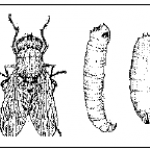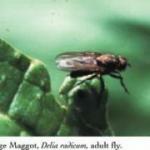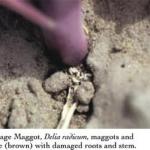Cabbage Maggot
One of the early groups of vegetables to go into the home vegetable garden are the Cole crops, which include such favorites as broccoli, Brussels sprouts, cabbage and cauliflower. These vegetables are relatively cold hardy and often are transplanted into the garden in mid to late April. Unfortunately, this also happens to be the time that the adult cabbage maggot fly is actively seeking these crops. The adult stage of the cabbage maggot is a fly similar in general appearance to the common housefly, but only about half as long (3 inch or 6.4 mm in length). They are dark ashy gray with black stripes on the thorax (chest region) and many black bristles over the body.
Flies are often attracted to gardens which have recently been recently turned or that have weedy areas. As flies enter a field, they fly close to the ground and deposit their small white eggs on the plants near where the stem meets the ground or in cracks and crevices in the soil. The eggs hatch and the very small maggots promptly seek the roots and eat into them. Each maggot feeds for three to four weeks, and the roots often become riddled with their tunnels and with many of the fibrous roots eaten off.
Plants attacked by the cabbage maggot (Delia radicum) appear sickly, off-color and stunted. If the attack is severe, they wilt suddenly during the heat of the day and die. Cabbage roots show brownish grooves over their surface and slimy winding channels running through the flesh.
While this pest used to require the use of an insecticide in order to harvest a decent crop, it now is easily controlled by cultural means. Remove any weedy areas in or near the garden. If possible, till the soil four to six weeks before planting. The use of floating row covers (spun bond fabrics) with the edges buried works very well in preventing the adult fly from laying eggs on the soil at the base of the plant, thus eliminating the need for any use of an insecticide.
Disclaimer - The most reliable information was included that was available at time this information was compiled. Due to constantly changing laws and regulations, UMass Extension can assume no liability for recommendations. The pesticide user is always responsible for the effects of pesticide residues on their own crops, as well as problems caused by drift from their property to other properties or crops. Always read and follow all instructions on the label.
WARNING! PESTICIDES CAN BE DANGEROUS. Read and follow all directions and safety precautions on container labels. Handle carefully, and store in original containers with complete labels, out of reach of children, pets, and livestock.


